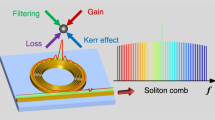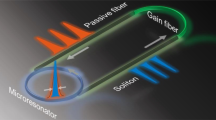Abstract
Temporal dissipative solitons in nonlinear optical resonators are self-compressed, self-stabilizing and indefinitely circulating wave packets. Owing to these properties, they have been harnessed for the generation of ultrashort pulses and frequency combs in active and passive laser architectures, including mode-locked lasers1,2,3,4, passive fibre resonators5 and microresonators6,7,8,9,10,11. Here, we demonstrate the formation of temporal dissipative solitons in a free-space enhancement cavity with a Kerr nonlinearity and a spectrally tailored finesse. By locking a 100-MHz-repetition-rate train of 350-fs, 1,035-nm pulses to this cavity-soliton state, we generate a 37-fs sech²-shaped pulse with a peak-power enhancement of 3,200, which exhibits low-frequency intensity-noise suppression. The power scalability unique to free-space cavities, the unprecedented combination of peak-power enhancement and temporal compression, and the cavity-soliton-specific noise filtering attest to the vast potential of this platform of optical solitons for applications including spatiotemporal filtering and compression of ultrashort pulses and cavity-enhanced nonlinear frequency conversion.
This is a preview of subscription content, access via your institution
Access options
Access Nature and 54 other Nature Portfolio journals
Get Nature+, our best-value online-access subscription
$29.99 / 30 days
cancel any time
Subscribe to this journal
Receive 12 print issues and online access
$209.00 per year
only $17.42 per issue
Buy this article
- Purchase on Springer Link
- Instant access to full article PDF
Prices may be subject to local taxes which are calculated during checkout





Similar content being viewed by others
Data availability
The data that support the plots within this paper and other findings of this study are available from the corresponding authors upon reasonable request.
References
Mollenauer, L. F. & Stolen, R. H. The soliton laser. Opt. Lett. 9, 13–15 (1984).
Brabec, T., Spielmann, C. & Krausz, F. Mode locking in solitary lasers. Opt. Lett. 16, 1961–1963 (1991).
Haus, H. A. Mode-locking of lasers. IEEE J. Sel. Top. Quant. Electron. 6, 1173–1185 (2000).
Grelu, P. & Akhmediev, N. Dissipative solitons for mode-locked lasers. Nat. Photon. 6, 84–92 (2012).
Leo, F. et al. Temporal cavity solitons in one-dimensional Kerr media as bits in an all-optical buffer. Nat. Photon. 4, 471–476 (2010).
Herr, T. et al. Temporal solitons in optical microresonators. Nat. Photon. 8, 145–152 (2014).
Saha, K. et al. Modelocking and femtosecond pulse generation in chip-based frequency combs. Opt. Express 21, 1335–1343 (2013).
Liang, W. et al. High spectral purity Kerr frequency comb radio frequency photonic oscillator. Nat. Commun. 6, 7957 (2015).
Yi, X., Yang, Q.-F., Yang, K. Y., Suh, M.-G. & Vahala, K. Soliton frequency comb at microwave rates in a high-Q silica microresonator. Optica 2, 1078–1085 (2015).
Brasch, V. et al. Photonic chip–based optical frequency comb using soliton Cherenkov radiation. Science 351, 357–360 (2016).
Obrzud, E., Lecomte, S. & Herr, T. Temporal solitons in microresonators driven by optical pulses. Nat. Photon. 11, 600–607 (2017).
Pasquazi, A. et al. Micro-combs. A novel generation of optical sources. Phys. Rep. 729, 1–81 (2018).
Jang, J. K., Erkintalo, M., Murdoch, S. G. & Coen, S. Ultraweak long-range interactions of solitons observed over astronomical distances. Nat. Photon. 7, 657–663 (2013).
Xue, X. et al. Mode-locked dark pulse Kerr combs in normal-dispersion microresonators. Nat. Photon. 9, 594–600 (2015).
Jones, R. J. & Ye, J. Femtosecond pulse amplification by coherent addition in a passive optical cavity. Opt. Lett. 27, 1848–1850 (2002).
Gohle, C. et al. A frequency comb in the extreme ultraviolet. Nature 436, 234–237 (2005).
Adler, F., Thorpe, M. J., Cossel, K. C. & Ye, J. Cavity-enhanced direct frequency comb spectroscopy: technology and applications. Annu. Rev. Anal. Chem. 3, 175–205 (2010).
Foltynowicz, A., Ban, T., Masłowski, P., Adler, F. & Ye, J. Quantum-noise-limited optical frequency comb spectroscopy. Phys. Rev. Lett. 107, 233002 (2011).
Cingoz, A. et al. Direct frequency comb spectroscopy in the extreme ultraviolet. Nature 482, 68–71 (2012).
Benko, C. et al. Extreme ultraviolet radiation with coherence time greater than 1 s. Nat. Photon. 8, 530–536 (2014).
Reber, M. A. R., Chen, Y. & Allison, T. K. Cavity-enhanced ultrafast spectroscopy: ultrafast meets ultrasensitive. Optica 3, 311–317 (2016).
Holzberger, S. et al. Femtosecond enhancement cavities in the nonlinear regime. Phys. Rev. Lett. 115, 23902 (2015).
Coen, S. & Haelterman, M. Modulational instability induced by cavity boundary conditions in a normally dispersive optical fiber. Phys. Rev. Lett. 79, 4139–4142 (1997).
Lucas, E., Guo, H., Jost, J. D., Karpov, M. & Kippenberg, T. J. Detuning-dependent properties and dispersion-induced instabilities of temporal dissipative Kerr solitons in optical microresonators. Phys. Rev. A 95, 043822 (2017).
Coen, S. & Erkintalo, M. Universal scaling laws of Kerr frequency combs. Opt. Lett. 38, 1790–1792 (2013).
Xu, Y. & Coen, S. Experimental observation of the spontaneous breaking of the time-reversal symmetry in a synchronously pumped passive Kerr resonator. Opt. Lett. 39, 3492–3495 (2014).
Hendry, I. et al. Spontaneous symmetry breaking and trapping of temporal Kerr cavity solitons by pulsed or amplitude modulated driving fields. Phys. Rev. A 97, 053834 (2018).
Schulte, J., Sartorius, T., Weitenberg, J., Vernaleken, A. & Russbueldt, P. Nonlinear pulse compression in a multi-pass cell. Opt. Lett. 41, 4511–4514 (2016).
Lilienfein, N. et al. Enhancement cavities for few-cycle pulses. Opt. Lett. 42, 271–274 (2017).
Lilienfein, N. et al. Balancing of thermal lenses in enhancement cavities with transmissive elements. Opt. Lett. 40, 843–846 (2015).
Mills, A. K. et al. An XUV source using a femtosecond enhancement cavity for photoemission spectroscopy. Proc. SPIE 9512, 95121I (2015).
Corder, C. et al. Ultrafast extreme ultraviolet photoemission without space charge. Struct. Dyn. 5, 054301 (2018).
Saule, T. et al. High-flux ultrafast extreme-ultraviolet photoemission spectroscopy at 18.4 MHz pulse repetition rate. Nat. Commun. https://doi.org/10.1038/s41467-019-08367-y (2019).
Kumkar, S. et al. Femtosecond coherent seeding of a broadband Tm:fiber amplifier by an Er:fiber system. Opt. Lett. 37, 554–557 (2012).
Wunram, M. et al. Ultrastable fiber amplifier delivering 145-fs pulses with 6-μJ energy at 10-MHz repetition rate. Opt. Lett. 40, 823–826 (2015).
Acknowledgements
The authors gratefully acknowledge helpful suggestions from T. Herr and A. Apolonskiy. The authors thank S. Breitkopf and T. Buberl for assistance with the laser system, J. Gessner for phase measurements of cavity mirrors and M. Fischer for support concerning the offset-frequency stabilization. The authors thank the European Research Council (ERC) (617173), Deutsche Forschungsgemeinschaft (DFG) Excellence cluster ‘Munich Centre of Advanced Photonics’ (MAP) for funding.
Author information
Authors and Affiliations
Contributions
N.L., C.H. and I.P. planned and coordinated the experiments. N.L. designed and performed the experiments, and analysed the data. C.H., T.S., M.H. and I.P. assisted with experiments and data analysis. M.H. and N.L. developed the model and performed the simulations. V.P. and M.T. designed and produced the cavity optics. E.F. contributed to the experimental concept. C.R. and A.L. conceived and implemented the spectral shift of the erbium oscillator for seeding the ytterbium amplifier system. J.L. designed and provided the amplifier system. N.L., M.H. and I.P. wrote the manuscript with input from all other authors. I.P. and F.K. supervised the project.
Corresponding authors
Ethics declarations
Competing interests
The authors declare no competing interests.
Additional information
Publisher’s note: Springer Nature remains neutral with regard to jurisdictional claims in published maps and institutional affiliations.
Supplementary information
Supplementary Information
This file contains more information on the simulation methods and results, and Supplementary Figures 1–8.
Supplementary Video 1
Locking procedure.
Rights and permissions
About this article
Cite this article
Lilienfein, N., Hofer, C., Högner, M. et al. Temporal solitons in free-space femtosecond enhancement cavities. Nature Photon 13, 214–218 (2019). https://doi.org/10.1038/s41566-018-0341-y
Received:
Accepted:
Published:
Issue Date:
DOI: https://doi.org/10.1038/s41566-018-0341-y
This article is cited by
-
Ultrashort dissipative Raman solitons in Kerr resonators driven with phase-coherent optical pulses
Nature Photonics (2024)
-
Zero dispersion Kerr solitons in optical microresonators
Nature Communications (2022)
-
Temporal walk-off induced dissipative quadratic solitons
Nature Photonics (2022)
-
Extreme-ultraviolet frequency combs for precision metrology and attosecond science
Nature Photonics (2021)
-
Temporal solitons in a coherently driven active resonator
Nature Photonics (2021)



